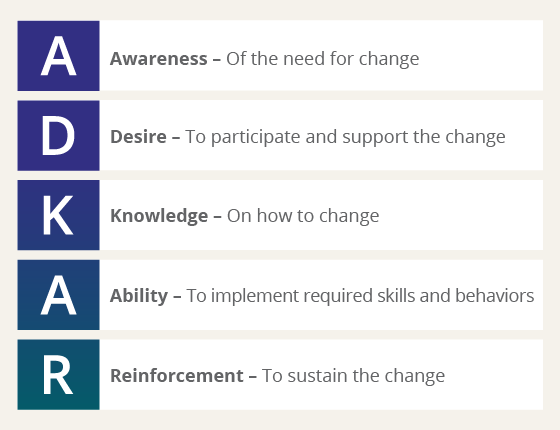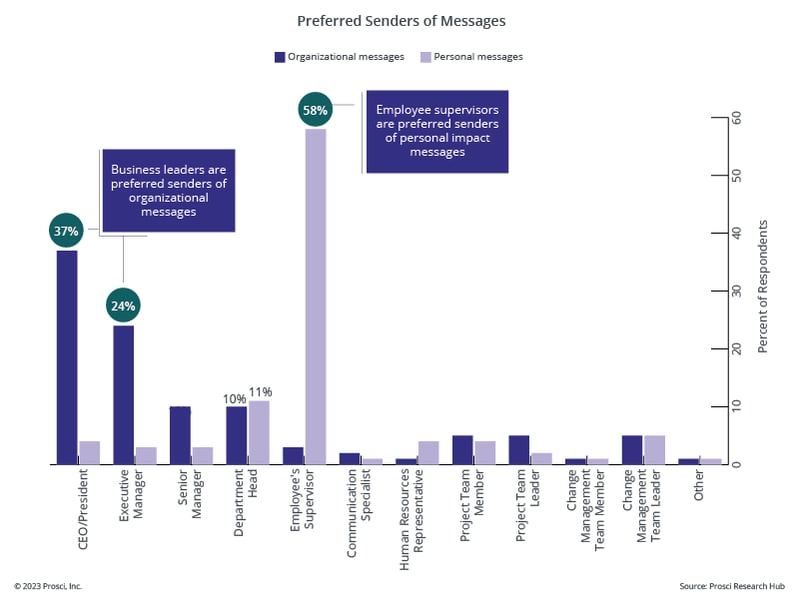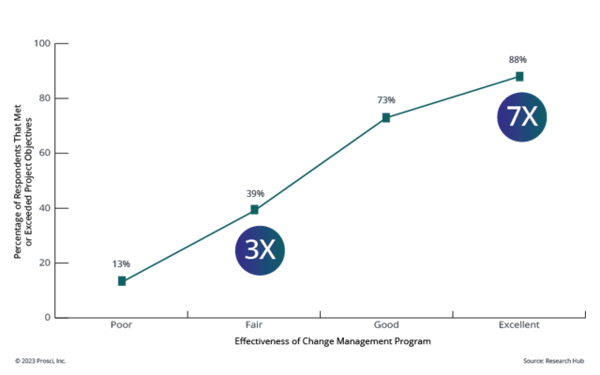Applying the ADKAR Model When Change Management is New

6 Mins
Updated: February 7, 2025
Published: March 23, 2022

If you're just beginning to implement change management on a project, it's important to remember that for many people participating, change management is a foreign concept. The effective application of change management principles and tools is itself a change for them. Here's how the ADKAR Model can help.
ADKAR and Change Management as a Change
Maybe you're working with a newly promoted senior leader who has participated in changes but never fulfilled the role of a sponsor. Perhaps some of your project team members are well versed in project management methodologies and tools but have not been exposed to change management. Or maybe the functional managers brought onto the change management team to share insights and expertise from their particular areas have no understanding of change management concepts or tools.
In each of these cases, the individuals are undergoing a change themselves—the change of applying effective change management. Because they are going through the change as individuals, we can use the Prosci ADKAR Model to examine the key steps, messages and information required to get change management team members successfully through the personal change (remember, applying effective change management is the change we are talking about).
ADKAR and "Applying Effective Change Management"
Any change takes place one individual at a time. Change also takes place sequentially as each individual moves through the phases of the ADKAR Model. The questions, talking points and actions below highlight how you can address the need to apply effective change management in your organization at each stage of the ADKAR Model.

Awareness of the need to apply effective change management
Asking your teams to apply change management first requires making the need for change management concrete. When someone is asked to change the way they do things (i.e., apply change management on your next project), the first response is usually, "Why?"
At the Awareness, employees will ask:
"Why is change management necessary and why now?"
"What's wrong with the way we are implementing changes today?"
"What will happen if we don't use change management?"
Talking points and actions you can take to build Awareness:
- Highlight past failures or transition problems in the organization where change management was not effectively applied. This creates a common reference point for your team, so the messages going forward have more impact. Talk about the impacts of those past changes and which key steps were missed.
- Provide concrete examples of the risks of poorly managed change. Costs and risks of poorly managed change include lower productivity, loss of valued employees, decreased morale, slow adoption, passive resistance (including lack of commitment), active resistance (including sabotage), and possible failure of the change.
- Share change management research findings. Prosci's Best Practices in Change Management report reveals several key points that can help you support Awareness. For example, the number one thing teams would do differently on their next project is involve change management earlier during the project planning phase. Practitioners also identified customized and scaled change management activities as a key component of an effective change management strategy.
- Offer foundational resources. Prosci's book, Change Management: The People Side of Change, dedicates the first chapter to building the case for "why manage change." It's a great foundation for anyone new to managing the people side of change. Our Resource Center also offers a variety of free "getting started" articles, webinars, blogs and downloads.
- Bring in a leader to advocate for the use of change management. Our research shows that executives and senior leaders are the best senders of messages related to the business need for change. This is true for applying change management as well. Having an executive speak to your team about the importance of change management for the organization will be a key success factor.

Desire to participate in and support effective change management application
Desire is typically one of the most difficult phases because it requires individuals to make their own decision. You want to make a compelling case for adopting change management and build on the Awareness created earlier.
When building Desire, employees ask:
"What's in it for me (WIIFM)?"
"What are the benefits of change management for the organization?"
"Why should I get on board?"
Key talking points and actions to build Desire:
- Share case studies that show where change management has made an impact. Bring in people from within or outside your organization to share their experiences on projects that successfully applied change management. Some people on your team will also need concrete examples to support the concept.
- Share benchmarking findings that show the impact of change management. Prosci’s correlation data consistently shows that initiatives with excellent change management are seven times more likely to meet objectives than those with poor change management. By simply moving from “poor” to “fair,” change management nearly triples the likelihood of meeting objectives.

- Leverage senior leadership. Prosci research shows that the sponsor (the leader championing the change) is the number one contributor to successful change. Likewise, the role of the sponsor responsible for the application of change management is also critical for your success. Active and visible support for applying change management by a senior leader shows commitment and builds Desire with team members.
- Find effective coaches. The relationship between employees and their people managers is significant, which makes coaching a powerful tool for building Desire. Identify which of the team's supervisors can serve as coaches of change and prepare them with the awareness and knowledge they need (coaching may be an individual change for your supervisors too).
- Enlist, engage and empower sponsors. The most critical resources for building Desire are senior leaders and the employees' direct supervisors. Learn how to enlist, engage and empower your sponsors by watching this webinar. The Prosci Resource Center also has a number of free articles, worksheets and other webinar recordings on overcoming resistance and engaging supervisors.
Knowledge about how to apply change management
The key mechanism for creating Knowledge is training. Unfortunately, many organizations fail to address Awareness and Desire first, and attempt to build buy-in by training people. This approach is ineffective. It can create resistance and make adoption more difficult. Make sure that your team has Awareness of the need for change management and a Desire to engage before initiating training.
Questions people have around Knowledge include:
"What skills are involved in implementing change management?"
"How do I obtain these skills?"
Key talking points and actions around Knowledge:
- Teach the team how individuals go through change. To be an effective manager of change, people need to understand how an individual experiences change. Whether it's your project team, communications staff, human resources personnel, senior leaders and executives, supervisors, or front-line employees—everyone will be better equipped to handle and manage change when you give them a solid understanding of the ADKAR Model.
- Teach organizational change management principles and processes. The team should be exposed to the change management methodology you will be using for your project. This may be a methodology selected specifically for the project or one developed and deployed across your organization. Organizations are using both internally developed methodologies and externally provided approaches. The key is that your team understands what change management tools they have (communications, sponsorship, coaching, training, etc.) and when and how to use these tools.
- Get the right training and tools. Prosci offers a variety of training solutions to teach key concepts and give participants experience applying them in real time to actual changes at work. Prosci Change Management Certification Program attendees also receive access to Prosci's 3-Phase Process, templates, checklists, assessments and guidelines to streamline application.

Ability to implement new skills and behaviors related to change management
Ability is the fourth stage individuals reach after Awareness, Desire and Knowledge. Once an individual reaches the Ability stage, the team can act on the Knowledge individuals acquired through the change management process.
Questions people ask around Ability include:
"Once I have the Knowledge, will I be able to act on it?"
"What do I do when I have problems or questions?"
Key talking points and actions for growing Ability include:
- Consider the time and activities needed to develop new skills. Imparting Knowledge of how to change doesn’t automatically bring about change. It requires people to act in a new way (i.e., demonstrating Ability) for the change to be realized. You can foster Ability by providing hands-on instruction, one-on-one coaching, and access to subject matter experts.
- Coach change management practitioners. Coaching by experienced and skilled people is a great way to support and build Ability in your change team.
- Engage in two-way communication. While knowledge can sometimes be conveyed in a one-directional manner, you need to be available to hear concerns and questions and respond with direction and clarification. Two-way communication helps solidify Knowledge, so employees can act on it.
- Get interactive in your training sessions. Learning by doing is one of the most important ways to build Knowledge and Ability, especially in adult learning. Prosci's Change Management Certification Program is built around participants working on an actual or simulated change they bring from their job. During the program, participants create the communication plan, do the sponsor assessment, identify special tactics, and more as they learn and apply the concepts. This builds Ability while transferring Knowledge.
- Share Knowledge-building resources. Your internal coaches and support staff are a great resource, especially when you provide these individuals the tools and information they need to effectively support project teams and change management teams during implementation.
Reinforcement to keep change management in place
Changes in large organizations can be temporary if employees revert back to the old way of doing things. If you've identified change management as important to ensuring effective changes in your organization, you cannot risk reverting to the old ways of doing things.
Questions people ask at the Reinforcement stage:
"What happens when we are successful?"
"What is the reward?"
"Will there be smaller rewards along the way to encourage us?"
Some key talking points and actions around Reinforcement include:
- Engage senior leaders. Active and visible sponsorship for applying change management will have a significant impact on how often it is applied. Leaders must endorse change management as an integral part of all future projects. They also must hold project teams accountable for applying change management on their projects.
- Monitor progress and create measurement systems. As with any other change you expect employees to adopt, there must be a way to gauge success. This may include status meetings, surveys, and metrics. Create schedules and stick to them. Show your results.
- Align incentives. Be sure your incentives line up with project goals, so you drive the behaviors you want for the change itself and your change team.
- Celebrate successes. Identifying and celebrating successes is important because it reinforces the commitment to applying change management. It also keeps morale high and can create additional momentum.
Effective Change Management
With the ADKAR Model
The questions, talking points and actions above can help you create the buy-in you need to pursue change management effectively on projects. This information will also help you anticipate and address the common issues that can hold people back during any change. Most importantly, remember that change takes place sequentially. Individuals are unlikely to adopt change effectively if you try to skip over one or more of the stages. By the time you get to training, you want to maximize your investment by imparting knowledge and skills to people who are ready to be there.

